
- Share via
There is an episode of “The Twilight Zone” in which Earth is getting closer to the sun. Temperatures get hotter by the minute. Paint melts off canvases, thieves break into homes to steal water, and highways are jammed with people seeking cooler destinations they will never find.
As the few apartment dwellers who remain in a major city sweat and fret beneath the glaring sun, a radio announcer delivers an unfathomable weather report: Conditions are so hot that people can “fry eggs on sidewalks” and “heat up soup in the ocean.”
The temperature he provides in this nightmarish future?
110 degrees.
The joke, of course, is that six decades after that episode aired, the prospect of a bone-dry city soaring to 110 degrees is no longer an imaginary horror.
In 2020, Los Angeles recorded its all-time hottest temperature, 121 degrees, in Woodland Hills. Over the last decade, thermometers in that neighborhood have climbed to 110 degrees or hotter at least two dozen times.
Without urgent and immediate action, Los Angeles could be trapped in its own version of “The Twilight Zone.”
Will it be a fiery landscape where sizzling sidewalks cause second-degree burns, wildfire smoke blots out the sun, and water flows only sometimes, and mostly not at all?
Or will California’s penchant for innovation be our salvation, transforming Los Angeles into a place where every drop of water is recycled and every resident has enough shade and cooling to survive?
Here’s a glimpse at what life could look like if we get it right.
You’ll be drinking toilet water (sort of)
One way to grasp the magnitude of L.A.’s climate challenge is to consider the great, silent sloshing under our feet. A vast labyrinth of pipes snakes beneath the city, delivering a resource critical to nearly every facet of life here.
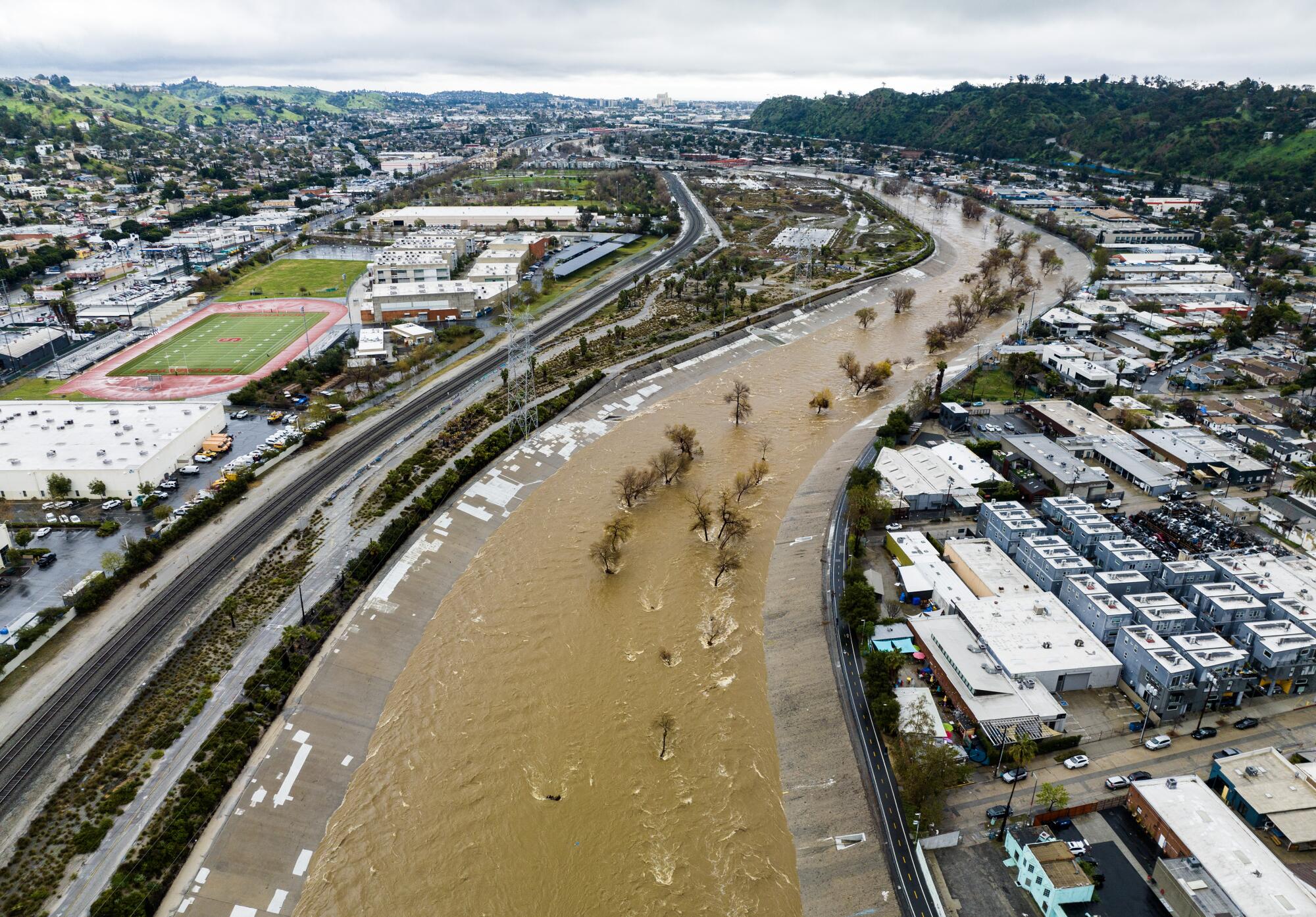
But the source of our water is the opposite of what we need to keep supplies flowing well into the future. When you turn on your tap, about 90% of that water comes from far away: the Owens Valley, Northern California and the Colorado River.
Only 8% comes from local groundwater, and even less — a paltry 2% — comes from recycling, or wastewater that is cleaned, repurposed and reused. Officials cringe when they hear the recycling process called “toilet-to-tap” because they fear it will turn the public off to a critical source of water. But the future of Los Angeles depends on just that.
When you turn on your faucet in 2035, at least 70% of the water will be sourced locally, and even more by midcentury. As you shower and brush your teeth, run your coffeemaker and water your houseplants, you’ll be reusing drops that only recently went down the drain.
“With groundwater, stormwater, recycled water and conservation, we can achieve self-sufficiency,” said Mark Gold, director of water scarcity solutions with the Natural Resources Defense Council.
The city has committed to recycling 100% of its wastewater for reuse by 2035 as part of its Green New Deal — a move that would represent a major leap toward water independence. Operation Next, a $16-billion undertaking from the Los Angeles Department of Water and Power and other agencies, is already underway, including major upgrades to the Hyperion Water Reclamation Plant, the city’s oldest wastewater treatment facility, which has been running since 1894. The project will clean and treat municipal wastewater so it can be added back to the city’s reservoirs, aquifers and municipal water lines for reuse.
Equally ambitious is Pure Water, a project from the Metropolitan Water District of Southern California — the largest water wholesaler in the nation — that will produce up to 150 million gallons of recycled, purified water each day, creating yet another new source for the region.
“We need a new vision,” MWD General Manager Adel Hagekhalil said, in an interview conducted prior to harassment allegations that are currently under investigation.
He invoked the spirit of William Mulholland, the engineer who oversaw construction of the Los Angeles Aqueduct more than 100 years ago, helping to fuel the city’s booming growth but also its insatiable thirst. He said a combination of local recycling projects and sustainability efforts are what’s needed to carry the region into the future.
“We’re at a crossroads,” Hagekhalil said. “It’s a ‘Mulholland moment’ for all of us to create the future for the next 100 years.”
You will drive an electric car — and drive a lot less
You’re cruising down the 101 Freeway in 2050, A/C cranking and music blaring, when you spot a relic from another era: a late 2020s crossover SUV. It brings you back to the days of gas stations and auto fumes. The car must be heading to a car show, part of some classic collection, you think, as you speed away in your solar-charged electric vehicle.
Today, California is working to make that vision a reality. The state is leading the nation in the transition to zero-emission vehicles and has pledged to ban all new gas car sales by 2035. Already, EVs comprise one out of every four cars sold here. Federal regulators are following suit with plans to limit tailpipe emissions and boost electric vehicle sales beginning in 2027.
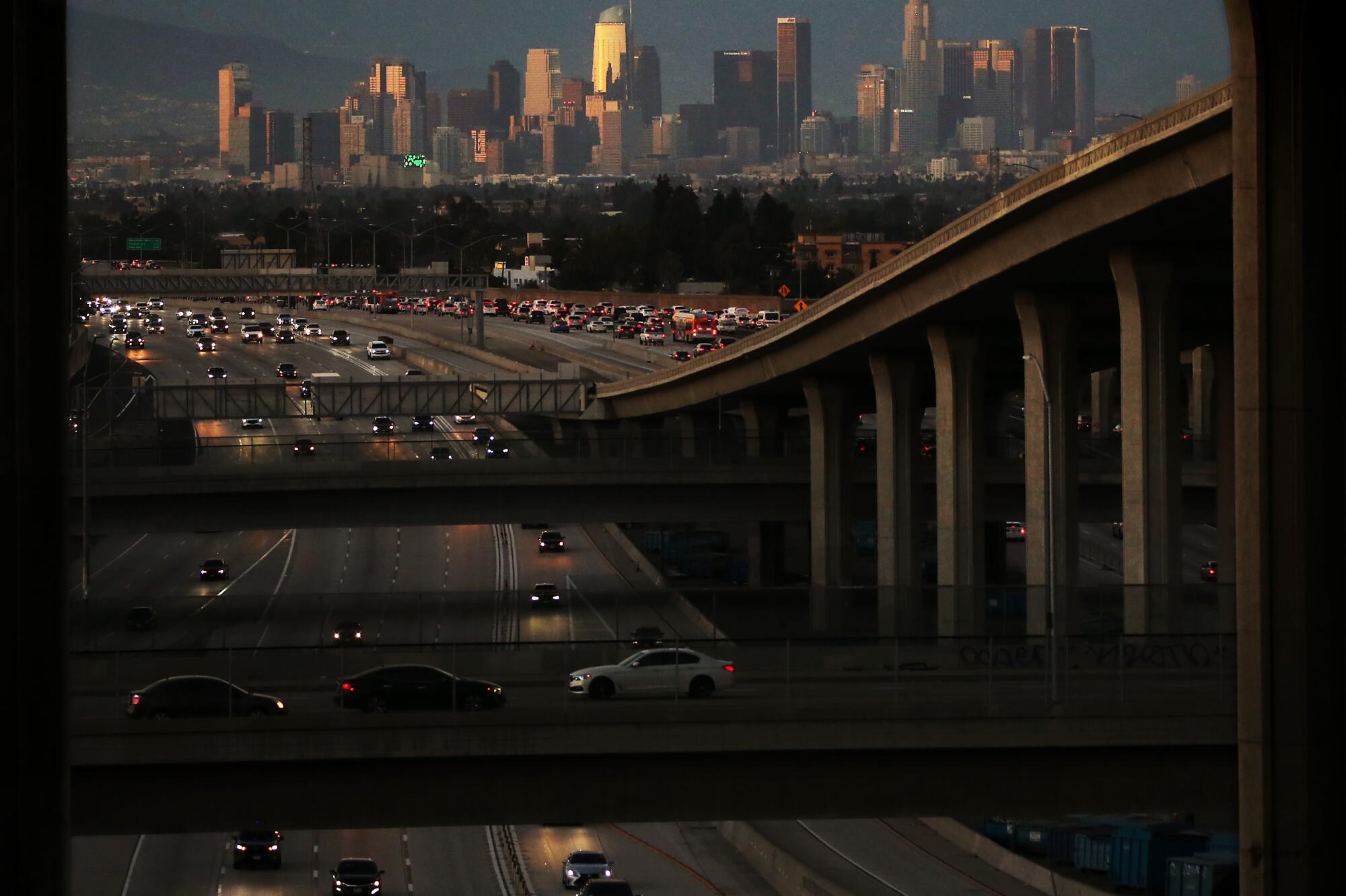
In Los Angeles, officials have set similarly ambitious goals of increasing the percentage of electric and zero-emission vehicles in the city to 100% by 2050 — which means not only banning sales of new gasoline cars, but also phasing old gas clunkers off the road. The city also aims to electrify its entire fleet of buses by 2030.
Those electric cars, trucks and buses will mostly run on renewable energy — primarily wind and solar power.
The move will be a crucial step in improving air quality and ridding L.A. of some of its infamous smog, since transportation currently accounts for the largest share of ground-level pollution and greenhouse gas emissions in the region.
But Los Angeles must also shed its car-centric identity in order to truly adapt to climate change. The famously sprawling metropolis will need to embrace electrified public transit, including a much-expanded system of bus rapid transit, express trains, e-bikes, light rail and robo-taxis.
“The future of cars should be electric, but the future should not be about cars,” said Rick Cole, L.A.’s chief deputy controller.
In order to get there, Angelenos will have to change not just how they get around, but also how they live. Picture housing above retail shops, sidewalks designed for leisure and dining, and a short walk — not a drive — to the nearest grocery store. It’s something some city planners have come to refer to as a “15-Minute City,” or a city in which most of a person’s needs can be met within a 15-minute walk, bike or transit trip.
The idea has already started gaining traction around the world, from the Netherlands to Colombia to Oregon. In Los Angeles County, officials in Lancaster are conducting a case study of the 15-minute city that has already transformed a stretch of its downtown from a barren roadway to a tree-lined boulevard.
Applied widely, the concept could make for a Los Angeles that is not just more hospitable, but also much cooler in the face of warming temperatures, said Stephanie Pincetl, founding director of the California Center for Sustainable Communities at UCLA.
“If we reduce the size of roads considerably and devote more of what’s there to bicycle transportation and buses and public transportation, we will be mitigating the urban heat island,” she said. “It’s not a brand new revolutionary technology, but it would be brand new revolutionary infrastructure.”
You’ll be sweatier
“The verdict is in, and we can expect that things are going to get hotter and drier for this region of the United States,” said Marianne Eppig, director of resilience with the Urban Land Institute.
In Los Angeles, average maximum temperatures are expected to increase by as much as 5 degrees by midcentury, along with an increase in extreme temperatures and extreme heat days, according to the state’s most recent climate change assessment.
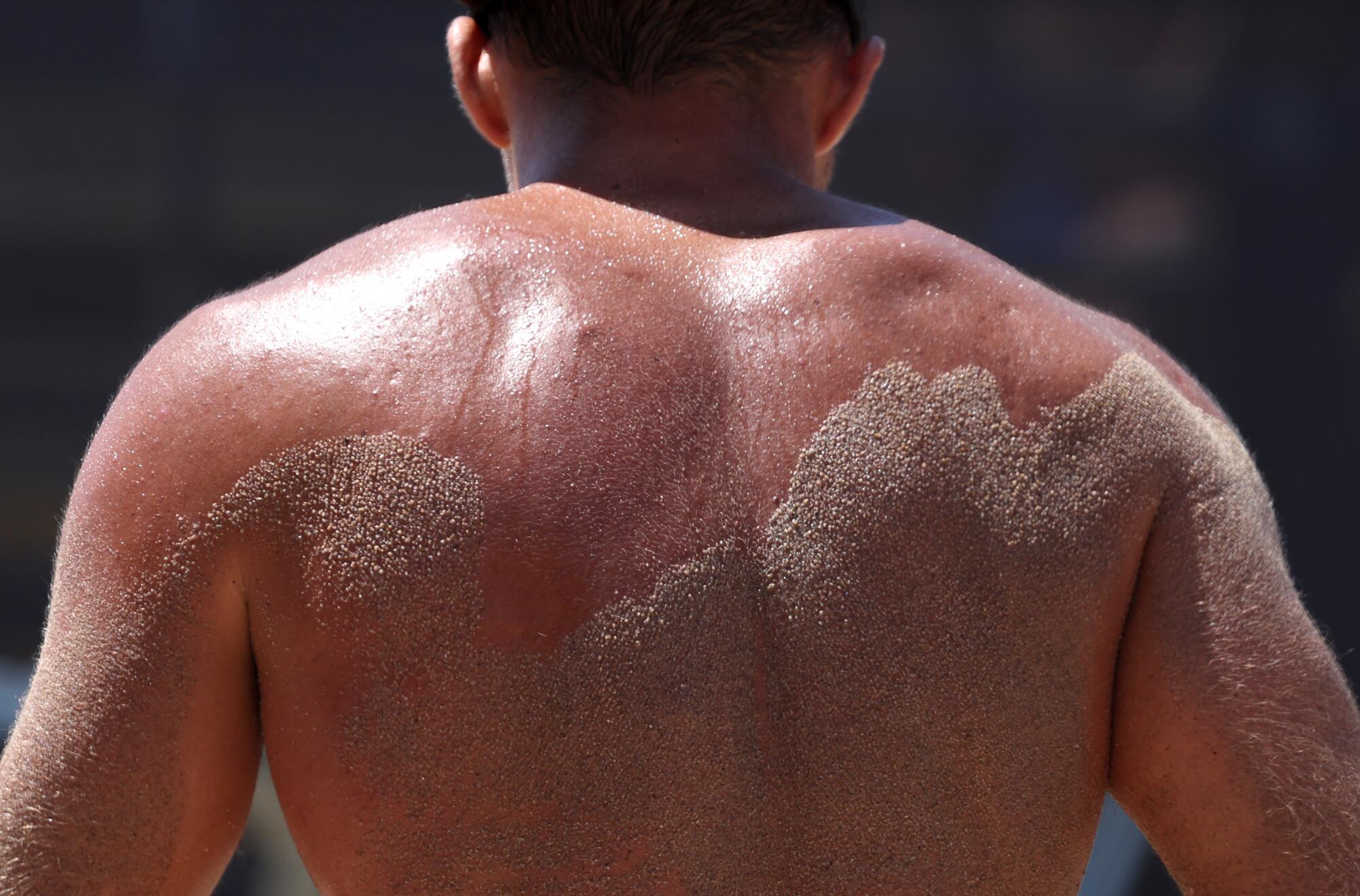
By 2050, the hottest day of the year could be up to 10 degrees warmer in many locations across the L.A. region. And by 2100, global warming could alter the seasons so significantly that summer-like conditions could last six months, one recent study found.
The heat isn’t hard to imagine. You’ll step out your door to sidewalks so hot they can burn flesh and temperatures so high they can ground airplanes — two phenomena that already happened during record-breaking Southwestern heat waves in 2023. Heat-outs, as opposed to rainouts, will postpone more and more of your beloved Dodgers games.
On high-heat days, emergency rooms will be filled with people suffering from heat stroke, many of them children and the elderly. The constant whir of leaf blowers will grind to a halt as temperatures become too hot for gardeners and outdoor workers during the day.
Heat waves will drive up the need for cooling, but heat pumps, not air conditioners, will become the norm. The devices run on electricity, and in warm weather, they work to absorb heat from inside your home and pump it outdoors, reducing energy costs by as much as 50%.
But cooling devices are only as efficient as the buildings in which they operate, said Matt Petersen, chief executive of the Los Angeles Cleantech Incubator. That means L.A. will need to retrofit old buildings with better windows, insulation and ceiling fans, and encourage new construction using materials and designs that prevent cool air from leaking out.
“It’s not simple,” he said, “but if you can do that with heat pumps, then you’ve got a great long-term solution.”
Indeed, those simmering temperatures are certain to change many facets of life in L.A., said Marta Segura, the city’s chief heat officer.
“Temperature is extremely important, but I think what is more important is our adaptation to it and the tools we use to mitigate it,” Segura said. “Our best bet is to ... do all that we can to not just reduce emissions, but to create a more resilient city.”
You won’t have a lawn
Lawns remain a common luxury in Los Angeles, but they are a relic of a much earlier era, when American settlers made their way west and brought with them the grass expanses that had thrived as status symbols in wetter East Coast cities. They were never meant for the Southland, where native plants soak up hours of daily sun and can go months without water.
Today, the lawn is among the biggest wasters of water in our urban environment — by some estimates accounting for more than half of the gallons used by city residents each year. In addition to private lawns, there are nearly 200,000 football fields’ worth of decorative grass in the city that will soon be illegal to water.
Future Los Angeles will need to look radically different — and closer to its true Mediterranean climate — if it is to survive. That means the grass has to go. But a lack of lawns doesn’t equate to a lack of life: Picture aromatic sagebrush, bright yellow sunflowers, flowering yuccas, humble scrubs and native grasses billowing in the breeze. (And yes, picture at least a few months of the year when all that stuff is mostly brown and dried out.)

The alternative is a city where you wake up some mornings and no water pours from your tap, or where the fire department plugs into a hydrant and nothing comes out, said Hagekhalil, of the MWD.
“Is that what we want?” he asked. “Or can we still make a difference, and make it happen where the future is green, with shade and shelter, where our landscape may not have all that grass but it looks beautiful?”
There are blueprints for such a transformation. Las Vegas, Phoenix, Mexico City and Barcelona have invested variously in native plants, trees and water-conscious policies and urban designs. California has approved a ban on watering nonfunctional turf — grass that is purely decorative — as soon as 2027.
Pincetl described the concept as a “generous city” — one in which neighborhoods have welcoming infrastructure such as corner drinking fountains and benches, and where shade structures and tree canopies line residential streets and commercial corridors. We can still lead an outdoor lifestyle even without the grass, she said.
“Urban design is what will make us have an agreeable, beautiful city where we will feel like we’re members of an important place,” she said.
You’ll see fewer palm trees, but you’ll have more shade
Your hybrid-electric plane is in a holding pattern above LAX in 2052. (No surprise, the airport is still being renovated.) But from your vantage point above, you can tell that the city looks different.
The palm trees that once defined L.A.’s streetscape are gone, replaced by live oaks, laurel figs and other leafy canopies — part of the city’s effort to adapt to reduced water supplies and hotter, drier conditions back in the 2030s and ’40s. The trees provide considerably more shade, cooling and carbon-sucking benefits than the non-native palms that came before them.

In fact, trees are and always have been one of the best solutions to L.A.’s climate woes, according to Segura, the city’s chief heat officer.
“It doesn’t have to be an innovative, new technology that we’re trying for the first time — we have technologies and solutions that we know work,” she said. “Nature-based solutions are really part of the future.”
Trees also help counteract the urban heat island effect, by which concrete, brick, asphalt and other hard surfaces absorb and reflect heat, increasing local temperatures by as much as 7 degrees. The effect is most pronounced in the city’s low-income neighborhoods and communities of color, which have far less tree cover than wealthier areas.
And unlike private lawns, which provide no community benefit, trees can form “shade arcades” throughout the city’s residential neighborhoods and commercial boulevards. A naturally shady streetscape will help to lower temperatures, improve air quality and reduce carbon dioxide while also providing habitats for birds and other species. It might even encourage people to walk, take scooters and ride bikes.
Not only will palm trees likely go the way of lawns, but there’s an opportunity to replace them with native plants (only one species of palm is actually native to California). Segura said that should include native trees that are going to be able to adapt to a hotter environment with less water, such as canyon live oaks.
“We need to count tree canopy and its maintenance as an infrastructure investment,” she said. “We should no longer look at it as something that’s nice to have, and not even as just the lungs of the city. It actually reduces the temperature and the urban heat island like no other solution.”
You’ll have cleaner air but more smoke days
When the dog you cloned back in 2037 starts crying for a walk, you reach for the leash on the hook next to your front door.
But then you catch a glimpse of an orange-gray sky through the window and think twice. You grab the face mask that hangs on the hook next to the leash — your best defense against the smoke that will be a regular part of L.A. life by the middle of the century.
Despite all the air quality gains made by cleaner cars and energy, experts today say the city will continue to face the prospect of more smoke days driven by wildfires, which are expected to become larger and more frequent due to climate change.
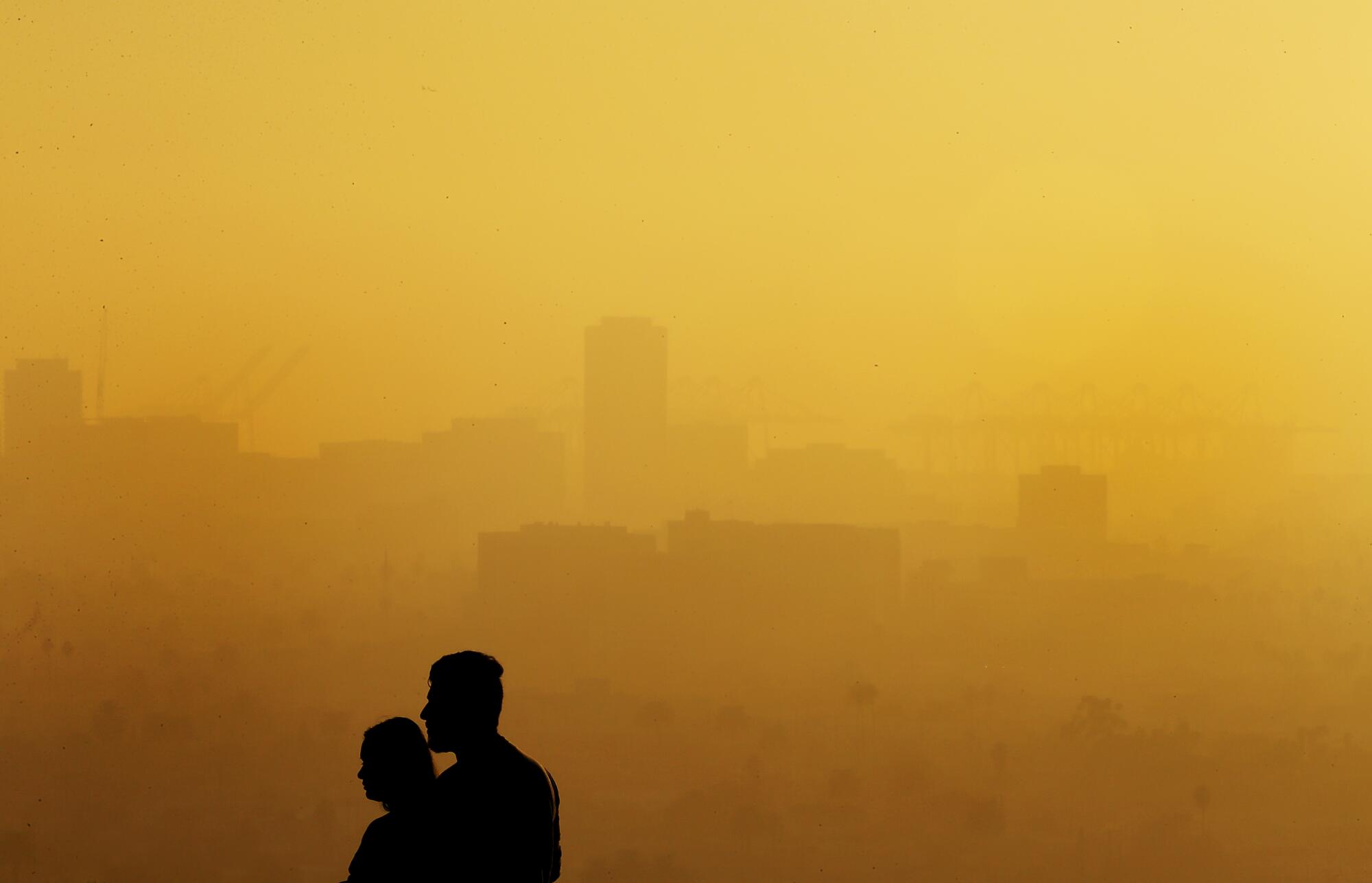
In California, average annual burn areas could increase by as much as 52% by 2050 depending on future emissions, one recent study found.
The good news is that when fires aren’t burning, you could enjoy a considerable improvement in the region’s air quality, which has ranked as the smoggiest in the nation in all but one of the last 24 years, according to the American Lung Assn.
The city’s efforts to electrify its transportation sector and transition to clean energy mean that most days, the air will be “significantly cleaner” by midcentury, said Will Barrett, the group’s national senior director of clean air advocacy. That includes an estimated $169 billion in public health benefits such as reduced asthma attacks and fewer premature deaths by 2050.
“The transportation sector absolutely needs to be cleaned up across the board with zero-emission technology, but we also have proactive things that need to happen with regard to wildfires,” Barrett said.
Among them are aggressive fuel reduction efforts and prescribed burns — initiatives Barrett estimates could cost the state $1 billion per year. Los Angeles and other communities should also continue to invest in clean air centers, while local air quality management districts and public health departments should receive more specific and sustained funding for climate preparedness work, Barrett said.
“We need action at the local, state and federal levels all moving in the same direction if we’re going to have a chance of meeting our near-term air quality standards, much less our long-term standards,” Barrett said.
You will seek coastal living — but it will be farther inland
An atmospheric river dumps 14 inches of rain in Venice Beach in 2057. You need to get some groceries for dinner, but your whole neighborhood is mired in 2 feet of standing water from precipitation and king tides. Guess it’ll be another night of dinner via drone delivery.
For those of us still in the 2020s, it may be tempting to orient L.A.’s future toward the coast and the natural cooling the Pacific Ocean provides. But sea-level rise driven by climate change will soon alter the landscape of what’s possible. Along the city’s shore, waters could rise nearly 2 feet by 2050 — making beachfront property something of an insurance and logistical nightmare.
Of course there will be lines of defense, such as seawalls, and sandbags. But in a race against nature, the ocean will win, with up to two-thirds of beaches in Southern California projected to disappear within a couple of decades.
As soon as 200 years from now, communities in Long Beach, Marina del Rey and other coastal areas will be gone, according to projections from Climate Central.
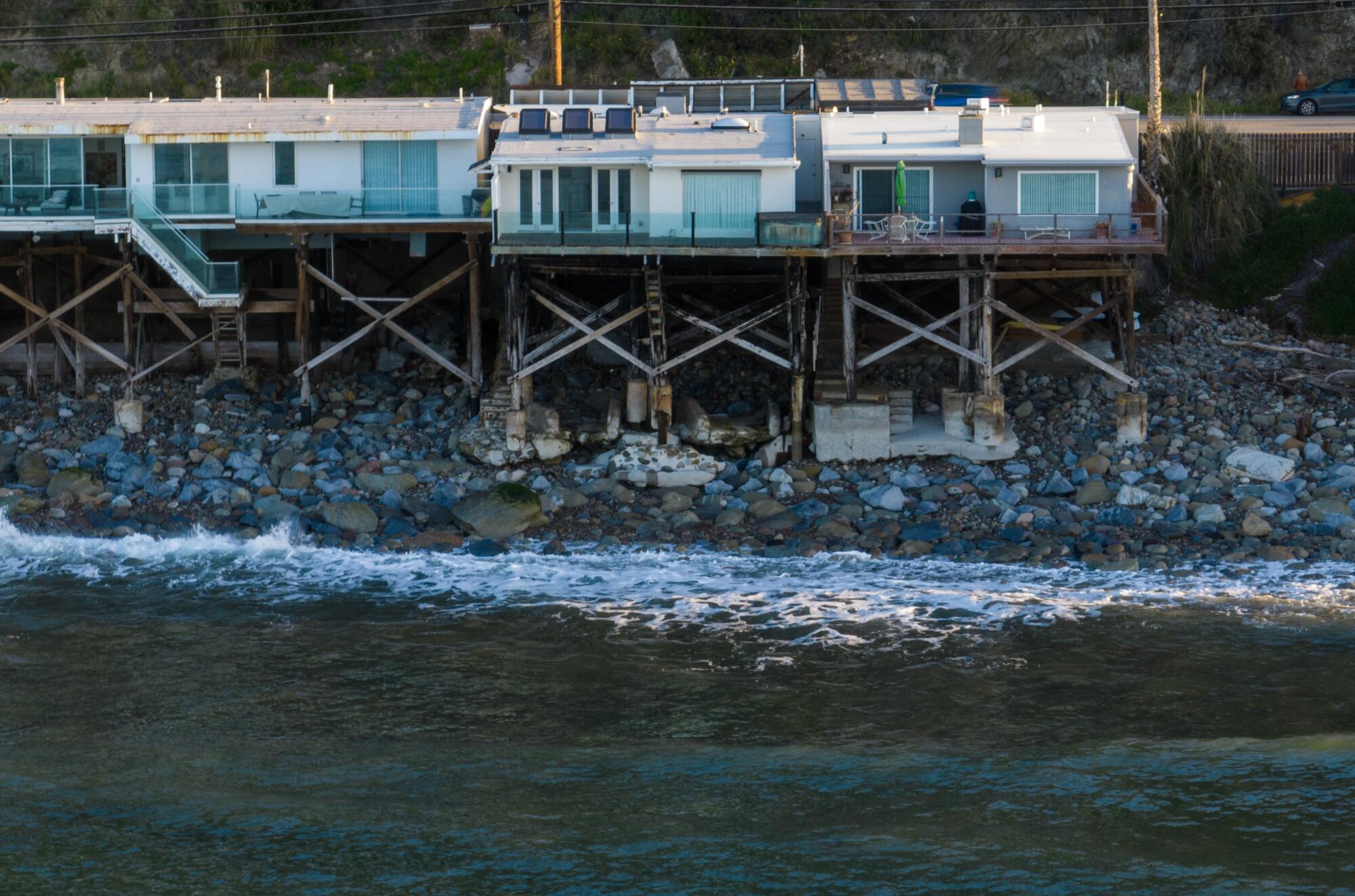
What’s more, the swelling sea will meet with large waves to create more onshore flooding and erosion along the coast, threatening not only homes but also infrastructure such as public beaches, coastal railways, storm drains and even Pacific Coast Highway. As a result, more and more people will move inland to avoid the hazards.
But there’s a limit to how far people will go, as inland areas will continue to experience hotter temperatures than coastal areas. Those who can afford it may try to get as close to the shore as reasonably possible in order to reap the benefits of ocean breezes and marine layers, which means swaths of low-rise housing not far from the sea will likely get much denser.
Such shifts will require urban planners to account for prevailing winds and create breezeways that align with natural patterns to let air move between tall buildings and through the city’s corridors, said Pincetl of UCLA.
Buildings with south-facing windows will benefit from overhangs that prevent the sun from coming in at the hottest times of day, she said, and roofs should be painted white. No buildings should be painted black, suggesting at least one decor trend won’t live on.
“It’s about really smart densification for the additional people that are moving in, and probably we’re going to have to retreat from various places,” Pincetl said.
You won’t see any mountain lions
It’s the 30th anniversary of the death of P-22, the beloved mountain lion/city mascot that died back in 2022. You’re taking your kid to the annual P-22 festival in Griffith Park when he asks you if mountain lions are made up, like dragons.
It’s been ages since the big cats were last seen within city limits. In fact, by the end of P-22’s lifetime, they were already being squeezed out of Southern California.
The loss is one of many ways the flora and fauna that color daily life in Los Angeles will be transformed by the region’s changing conditions. Some will adapt and thrive, while others, like the mountain lions, will struggle and vanish.
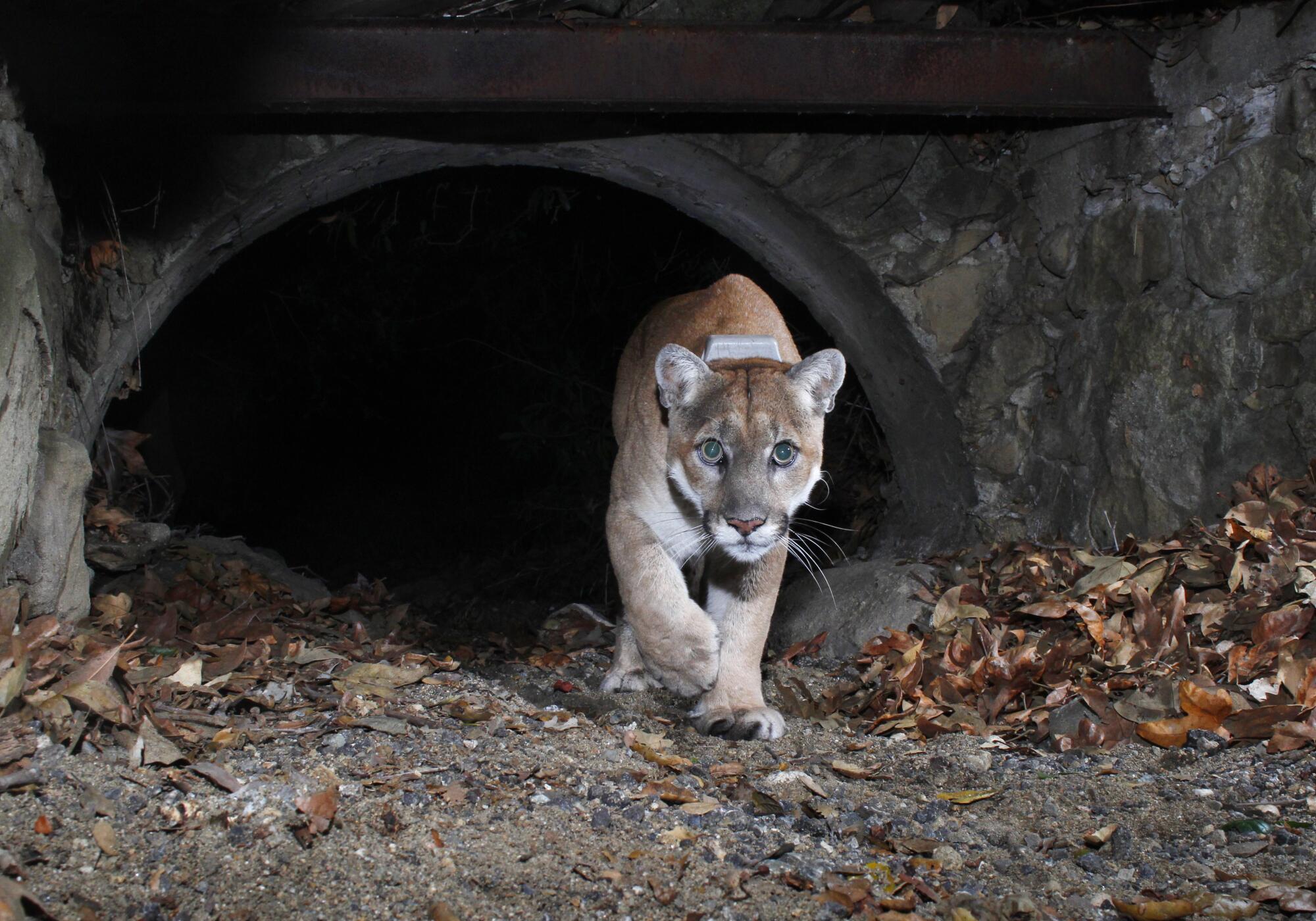
“It’s been really hard for our mountain lion populations down here in Southern California to be able to adequately move in the places that they need to move, and also inhabit the places that they need to inhabit,” said Kat Superfisky, an urban ecologist in Los Angeles. “So, unfortunately ... mountain lions are dwindling.”
Fortunately, the pumas’ extirpation from the region doesn’t mean they’ll be extinct everywhere in the U.S. And other urban critters, including coyotes, will likely keep doing just fine in Los Angeles. Coyotes are ambitious and social. They have become skilled at capitalizing on their relationship with humans, and they’ll probably still be part of life here in the 2050s.
A less welcome development is that mosquitoes may continue to thrive too. The bloodsuckers have been booming amid more extreme rainfall patterns and may continue to enjoy pools of standing water in the years to come. However, it’s possible that nature will bring more mosquito predators to Los Angeles to balance out their numbers — such as bats, spiders and birds.
In fact, the city’s entire bird population may undergo a transformation based on the changing environment, said Eric Wood, an associate professor of avian and urban ecology at Cal State Los Angeles.
“Urban birds” associated with humans, such as pigeons, European starlings and house sparrows, will likely continue to survive. But birds that are more sensitive to temperatures — and those whose prey can’t stand the heat — might suffer under persistent warming, such as yellow warblers and Bell’s vireos.
However, if the city is successful in planting more trees to help combat extreme heat, it could have the added benefit of hosting more birds such as acorn woodpeckers and California scrub jays. Hummingbirds might also expand their range given more plants for pollination.
“We can create ecosystems very mindfully and actually open up our doors in L.A. to a lot of different plants and animals that need these kinds of hotter, drier conditions,” Superfisky said.
You’ll use AI and smart devices to adapt to climate change
You’re riding your e-bike along the L.A. River in 2032 when dark clouds roll in. You remember that a big storm is coming, and you speed up to make it home before the deluge.
As you race down the bike path, you hear a pop and a whir, but it’s not your tires. Sensors have detected the impending storm too, and they’re deploying inflatable dams that will help capture rainfall in the channel so it can be added to the city’s water supply later on.
It’s one of many ways technology, innovation and artificial intelligence could color L.A.’s future. By midcentury, Angelenos will rely on AI to monitor air quality and detect leaks. AI will measure air pollutants and methane emissions, perform hyperlocal calculations of heat and radiant surface temperatures, and identify wasters and polluters.
AI could also identify climate disparities within communities in real time, such as neighborhoods that are dangerously hot during heat waves, or areas where water supplies or air quality are compromised by contaminants, and help deploy technicians to quickly address problems. Already in 2024, California is using AI to quickly spot and respond to wildfires.
There are other innovative ideas. Microgrids could keep energy flowing at the neighborhood level, while graywater systems and other household installations will help transform properties and communities into their own miniature water districts that are less reliant on external supplies that can face outages and strain.
Eppig, of the Urban Land Institute, pointed to a master-planned community in Colorado known as Sterling Ranch for inspiration. The community ties its irrigation to data from nearby weather monitoring stations and automatically waters less when conditions are damp and cool.
The community also uses separate meters for indoor and outdoor water use, with residents paying higher prices for water they use outdoors on lawns and in pools.
In San Diego, a high-density urban development known as Civita is outfitting every housing unit with a water meter panel, like a thermostat, to keep residents informed of their water consumption and help them catch leaks. The development also plans to build an on-site water reclamation plant and use computerized systems to control irrigation based on the weather.
But adapting to climate change is not just a technological and political challenge — it’s also a moral one, said Mark Arax, a former L.A. Times journalist and the author of “The Dreamt Land,” which describes vividly the state’s exploitation of water resources.
For too long, Californians believed that the state, with all of its vastness and beauty, could endure our excesses, Arax said. To truly adapt to the future will require a reckoning with our way of life.
“What we’re talking about is fundamentally altering the ‘California Dream’ to respond to something we should have responded to decades ago,” he said. “Climate change has now given us no choice.”
Toward a more sustainable California
Get Boiling Point, our newsletter exploring climate change, energy and the environment, and become part of the conversation — and the solution.
You may occasionally receive promotional content from the Los Angeles Times.








